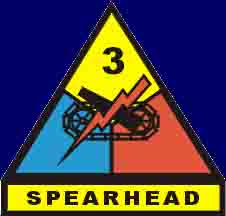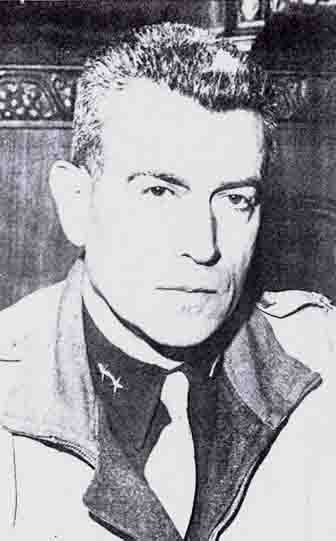| |
| |
|
|
| At
the Castle of Warelles at Quévy Le Grand where the Headquarters of
General Maurice Rose was installed during the Battle of Mons. The
headquaters were right in the center of the battle. A tank company
and an infantry company protected the castle. At one time, it had
been surrounded by German forces in retreat. Paul Wauters de Besterfeld,
who lived with his family in the castle and was a privileged observer
said that General Maurice Rose never worried. He was sure the US Air
Force would clear the surroundings very quickly. And that happened.
During that tragic episode of the liberation of Mons, a German officer
said "you Americans don't want to fight, you just want to slaughter
us"…General Maurice Rose was always at the head of his soldiers. That
is where he was killed on March 30th, 1945. In front of a German tank. |
| |
|
|
| |
| Meanwhile,
on March 30, the advance had been maintained by other elements of
the division, Task Force Welborn battered dug-in infantry and tanks
in the area north of Etteln. At approximately 1800 hours, his column
was cut by marauding Panther and Tiger tanks. It was not a serious
breach but, in the vicious, confused action which followed, the famous
commanding general of the "Spearhead" Division was killed in action.
It was a hard blow to men of the 3rd and a tragedy which was mourned
throughout the allied world. |
| |
| |
|
La
Jeep WHATZAT du Maj.Gén. Maurice ROSE
|
|
La
3e D.B.U.S. arrive dans les Faubourgs de Mons Le 2 septembre
en fin d'après-midi saluée par les habitants ravis d'être
enfin libérés.
|
|
|
|
|
| |
| The
general met his death on the evening of a great triumph. After an
irresistible drive of more than 100 miles, his tankers were approaching
the outskirts of the key city Paderborn and the citadel of German
armored force. Task Force Welborn was still moving ahead and the early
conclusion of his drive meant that the enemy's industrial Ruhr had
been almost completely encircled. The entire course of the war might
now balance upon the success of other allied forces driving to a swift
junction with the First Army spearhead. |
| |
| The
general's party, which consisted of three peeps, two motorcycles,
and an armored car, was following Welborn's group at dusk when the
column was cut by intense small arms fire from the woods on either
side of the narrow dirt road. General Rose, cradling a tommy-gun in
his arms, hit the ditch with his driver, T/5 Shaunce, and his aide,
Major Robert Bellinger. Up ahead, one of Welborn's tanks was destroyed
by a lance of direct fire, and a peep was also hit and reduced to
smoking junk. |
| |
| To
the rear, division officers, unaware of the general's predicament,
attempted to contact him by radio. The road-bound column was known
to be cut and Colonel John A. Smith, Jr., Chief of Staff, was worried.
The colonel knew that his fears were not unfounded when he received
a message from General Rose asking for a second task force, under
Colonel Doan, to close the gap and to expedite the action. This was
the "Spearhead" leader's last order. Minutes later he and his party
observed enemy tanks approaching from the rear. There was no alternative:
it had to be a headlong dash, cross country, in an effort to reach
the comparative safety of Colonel Welborn's task force. |
| |
| Under
a hail of bright tracer which stitched the gathering darkness in rapid
darts of flame, the small group raced froward and cut sharply to the
right. In the half-light, German infantry made full use of flares.
The vehicles were sharply outlined silhouettes and machine gun bullets
seemed to be going through and all around them. One of the motorcyclists
was forced to abandon his machine. He climbed aboard the armored car
and the procession went on. |
| |
| Upon
reaching the road down which Welborn's force had passed, the general's
party knew a moment of relief and then, looming out of the darkness
came a huge enemy tank. There was no turning back. Colonel Brown and
Shaunce both clipped the second of the lumbering vehicles but managed
to squeeze through. The third Panther swiveled sideways in the road.
Colonel Brown shot through a narrowing gap, hit the tank and tore
the front fender off his peep. Shaunce, desperately attempting the
impossible, came to a jarring halt, pinned by the mass of German armor
on one side and a tree on the other. A German tanker shouted a stream
of guttural commands and leveled a machine pistol. |
| |
| It
was impossible to tell exactly what happened next. General Rose, Major
Bellinger and T/5 Shaunce stood before the Nazi tank. There was a
fog of unreality about the whole situation. The enemy soldier was
undoubtedly frightened, and probably trigger-happy. Perhaps he thought
that General Rose was attempting to reach for a pistol. |
| |
| It
was dark there in the narrow road. Clouds obscured the moon. Shaunce
saw the enemy tank commander as a dim silhouette. He saw the man unaccountably
scream a final word, swing the burp gun and fire! There was an agonizing
moment when the ripping sound of the weapon, the spout of flame and
the sight of General Rose falling forward were all fused together
like a nightmare. And then Shaunce yelled and ran. So did Major Bellinger.
In this way the great commander of the "Spearhead" Division came to
his death. He fell at the head of his men, away up front where general
officers, according to popular belief, are not supposed to be. The
world mourned his passing. His troops scowled at the news and drove
forward as he would have wished them to do |
| |
| For
the most part, the rest of the general's party escaped. Major Bellinger
spent four nights and days behind enemy lines before he was liberated,
and T/5 Shaunce also had a nightmare of narrow escapes topped by final
rescue by elements of Task Force "X". Lt. Colonel Wesley A. Sweat,
Division G-3, who had commanded the armored car, and several of his
men were taken prisoner. A month later, Sweat was liberated by British
forces at Stalag XI-B, in Fallingbostel, Germany. |
| |
| Brigadier
General Doyle O. Hickey, pipe smoking, aggressive, long-time leader
of Combat Command "A", immediately assumed command of the division.
The men had perfect faith in Hickey. They proved their allegiance
by driving steadily forward. |
| |
| Bitterly,
men of Task Force "X", now commanded by Lt. Colonel John K. Boles,
Jr., a dynamic, boy-faced veteran of tank warfare, cleared the road-block
which had cut Welborn's column, and then went on to take Haxtergrund. |
| |
| At
Paderborn, the 3rd Armored Division was striking at the "Fort Knox
of Germany". Here the Reich's panzer elements were trained for battle
and it was these school troops, many of them officer candidates, who
came out to fight the American spearhead with tanks, tank-destroyers,
and the big bazookas which seemed to be Germany's last, potent weapon
of defense. The school troops of Paderborn fought well, but the grindstone
of battle was wearing Germany thin. |
| |
| German
soldiers and civilians alike were stunned by the swift approach of
American armor. Under the Nazi imbued of the Death's-Head SS, young
Germans who had trained at Paderborn, died on the grounds of their
military camp. Hitler may not have known it, but a majority of his
troops, taken on the western front at this time, were fully aware
of the fact that the jig was up. The POW enclosures were bursting
with disillusioned "supermen". In small fields adjacent to almost
every small town along the route they were standing, just waiting,
looking beat-up and numb after the flame of battle. Small groups continued
to ambush liaison men and messengers along the marching out in company
strength, waving white flags and looking for some one to officially
put them behind barbed
wire. |
| |
| In
clearing the Paderborn area, Lt Colonel William R. Orr's 1st Battalion
of the 36 Armored Infantry Regiment alone captured 136 cannon, ten
of which were active. Company "C", commanded by Lt. Robert J. Cook,
was first on the city's airfield. The company was immediately pinned
down by fire from two 88mm and eight 20mm flak weapons which Jerry
had converted to ground use. Division tanks and other heavy weapons
were brought up to take care of these defenses. |
| |
| On
April 1, the "Spearhead" Division had accomplished one of the great
drives of World War II, but the satisfaction of that victory was soured
by the news of General Rose's death. There was no slacking off in
the 3rd. |
| |
| Task
Force Kane was detached from the rest of the "Spearhead" and sent
on a swift drive to the west. Overrunning sharp oppositions, these
battle groups met elements of the 2nd Armored "Hell on Wheels" Division
at Lippstadt. The 2nd had come across the flat, north German plain
while the 3rd was making its two-way thrust, first to Herborn and
Marburg from the Remagen Bridgehead, and then north in a brilliant
crossing of the "T" to seal off the Ruhr. More than 376.000 enemy
soldiers were hopelessly enmeshed by that historic drive. Significantly,
the First United States Army announced that the mass encirclement
would henceforth be known as the "Rose Pocket" in honor of the great
general who was killed in action leading the first Americans to a
decisive victory over Germany. |
|



